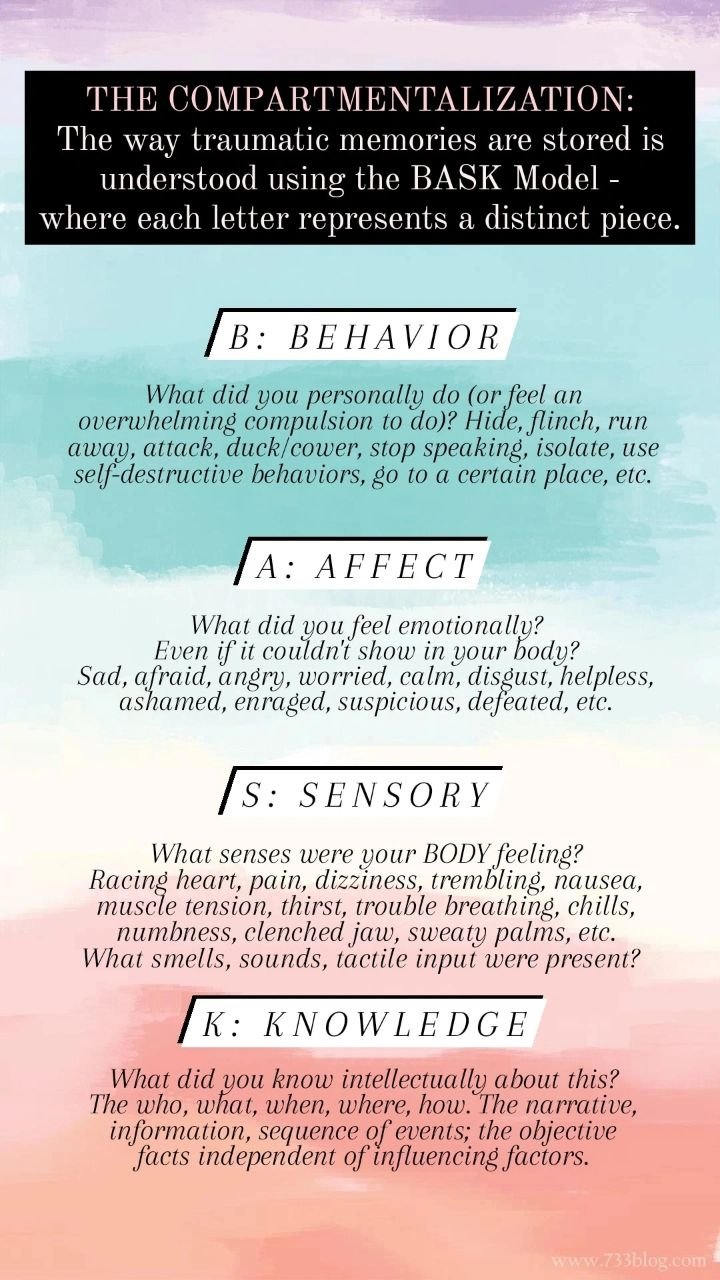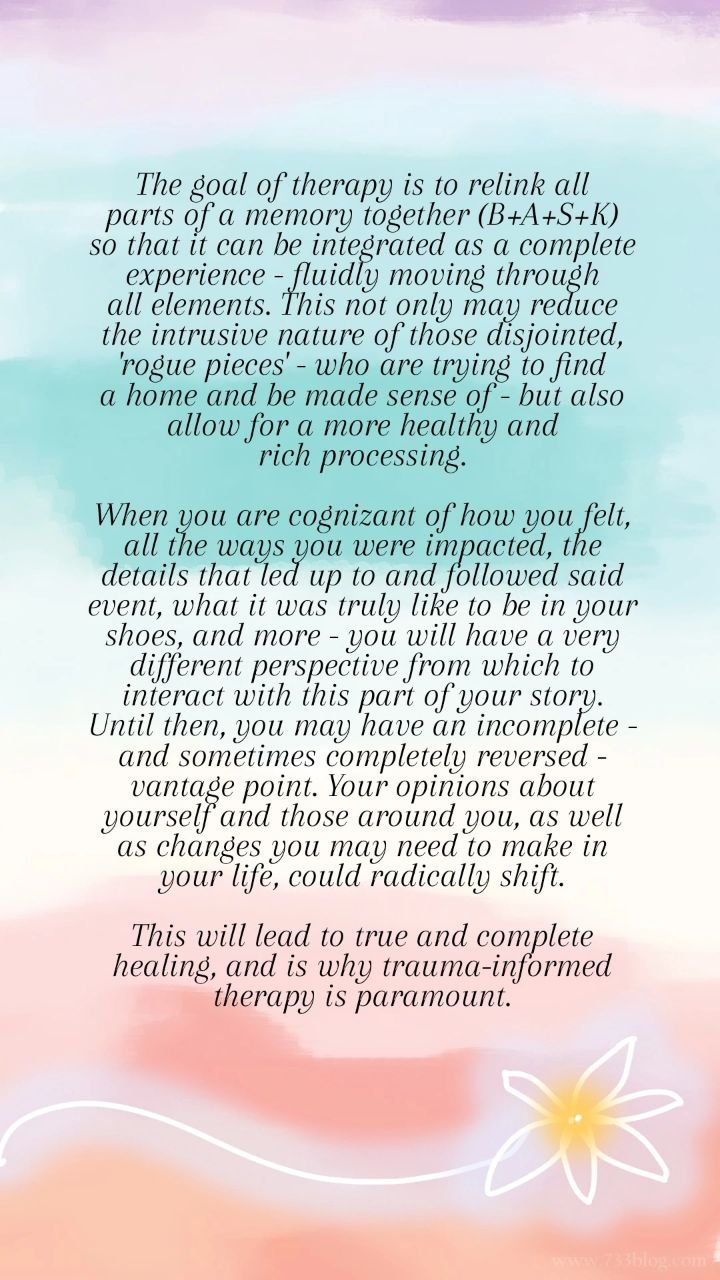In previous articles, we have talked a fair bit about flashbacks, particularly offering several tools and strategies to manage them. We have also discussed the more specific and unique phenomena of Emotional Flashbacks and Body Memories — all in the hopes of providing a few ways to work through them! But, we haven’t taken a proper detour into the mechanism behind all flashbacks, to really solidify the ways traumatic memory gets stored differently from regular, unfractionated, safe memory. To do this, we look to something called The BASK Model of dissociation and memory.
When a traumatic event occurs, for many folks, strong dissociation steps in as a means of self-protection. It helps compartmentalize the experience, or cast parts of it far outside of conscious thought, where it cannot be reached. It would be too distressing to be fresh on your mind, or even easily-accessible, when you're trying to go to work or are just making dinner. But, memories are made up of a vast, colorful array of mental, physical, emotional, and sensory experiences! Simplistically, we recognize them in four main categories: Behavior, Affect, Sensory, and Knowledge (BASK). We break down each of these further in the graphics below.



Let’s break those down a little further!
Behavior — What was the action in this memory? What did you physically do - or feel the overwhelming compulsion to do - with your body? Hide, flinch, run away, attack, duck/cover, stop speaking, yell, isolate, use self-destructive behaviors, go to a certain place, turn to stone, etc?
Affect — What were your emotions in this moment - even those stifled or shut-off? Were you sad, afraid, angry, worried, calm, disgusted, helpless, ashamed, enraged, suspicious, defeated, conflicted, intimidated, or even entirely numb or apathetic? Try to discern them from what you feel about the moment today.
Sensory — What were the sensations in your body? Racing heart, physical pain, thirst, trouble breathing, chills, numbness, clenched jaw, dizzy, sweaty palms, nauseous, muscle tension, off-balance/spinning, intoxicated, exhaustion, etc? Were you smelling anything in particular? Hearing specific things? Keys, footsteps, loud bangs, painful silence, whispering, creaking in a floor or door, cars, extreme weather, music, etc? Did you have any tastes? External feelings against your skin?
Knowledge — What were you intellectually aware of at the moment (the who, what, when, where, how)? The narrative, information, sequence of events? Additionally, what were your thoughts at the time? Even those that you later found out to be incorrect? What did you believe was happening or think to yourself as this moment was occurring?
During the unconscious process of putting thick dissociative barriers around this extremely sensitive material, some of those pieces scatter apart into far corners of the mind. They may each be fully detached from one another or linked up in unique, and sometimes perplexing, combinations. We know that a defining trait of PTSD, and one of its criterion for diagnosis, is "re-experiencing". When we push anything out of our awareness long enough (like when we stuff our feelings or pretend they don't exist for awhile) - but particularly if we've had to traumatically dissociate it away - it is likely to be intrusively thrust upon us against our will at some point. ...aaand typically when we're most vulnerable, least expect it, and it's the most inconvenient!
When we look to the BASK Model, and some of the unusual pairings that traumatic information can become linked, you can see how having them suddenly surface and come alive in your body without other important contextual pieces, can be deeply disorienting. It is understandably confusing, sometimes quite scary, and often easier to explain away by a hundred other things. You can now understand how this can manifest in symptoms like Body Memories (S + sometimes B), Emotional Flashbacks (A), or the ability to recount your trauma to someone without a single emotion or attachment to it in the world (K without A, and sometimes no B or S, either). Conversely, you may have every single indicator of a deeply terrifying event - it’s erupting in your thoughts, your skin, your emotions - and you know a trauma has to be there by context clues alone, but you’ve got zero intellectual awareness of what it is or where it's coming from (B+A+S). These scenarios only magnify in complexity when they’re become additionally scattered amongst parts of self in DID and OSDD systems.
The goal of traumatic processing is to find and link - or integrate - all these pieces to one another into one full, complete memory, then further integrate them into your self-concept, your narrative, the story of your life. If you're missing any vital pieces, not only are they still likely to revisit intrusively, but you may be drawing incomplete or inaccurate conclusions about the very trauma itself or what it means in the broader context of your life. You may believe a certain person in your life is much safer or more helpful than they really are; that you "didn't even react" when you maybe did so in a very powerful way; that you're at fault, when you unequivocally were not; that what occurred never hurt or 'wasn't that bad', when it very much did and absolutely was; that you felt fine, content, or enjoyment, when you really felt anger, disgust, or betrayal. The truth may completely reshape how you see yourself and everything around you. There is so much to be gleaned from these pieces coming together, and you deserve to know them in full, even though they're painful and difficult.
You also deserve to have control over your mind - no longer at its mercy when it throws these things at you when your guard’s at its lowest. Until then, we hope the some of the tools we have offered elsewhere can help to mitigate some of their effects (such as Flashbacks 101, Healing Pool/Light, Color Breathing, or Imagery with Dials), and additionally arm you with a different kind of strength and control over your symptoms.
Let's help take that power back!
MORE POSTS YOU MAY FIND HELPFUL:
✧ Grounding 101: 101 Grounding Techniques
✧ Distraction 101: 101 Distraction Tools
✧ Flashbacks 101: 4 Tools to Cope with Flashbacks
✧ Self-Care 101: 101 Self-Care Tools
✧ Nighttime 101 and Nighttime 201: Sleep Strategies for Complex PTSD
✧ Color Breathing 101: How to Calm Overwhelming Emotions and Physical Pain
✧ Imagery 101: Healing Pool and Healing Light
✧ DID Myths: Dispelling Common Misconceptions about Dissociative Identity Disorder
✧ Did You Know?: 8 Things We Should All Know about C-PTSD and DID
✧ Trauma and Attachment: 3-Part Series on Attachment Theory with Jade Miller
❖ Article Index ❖

